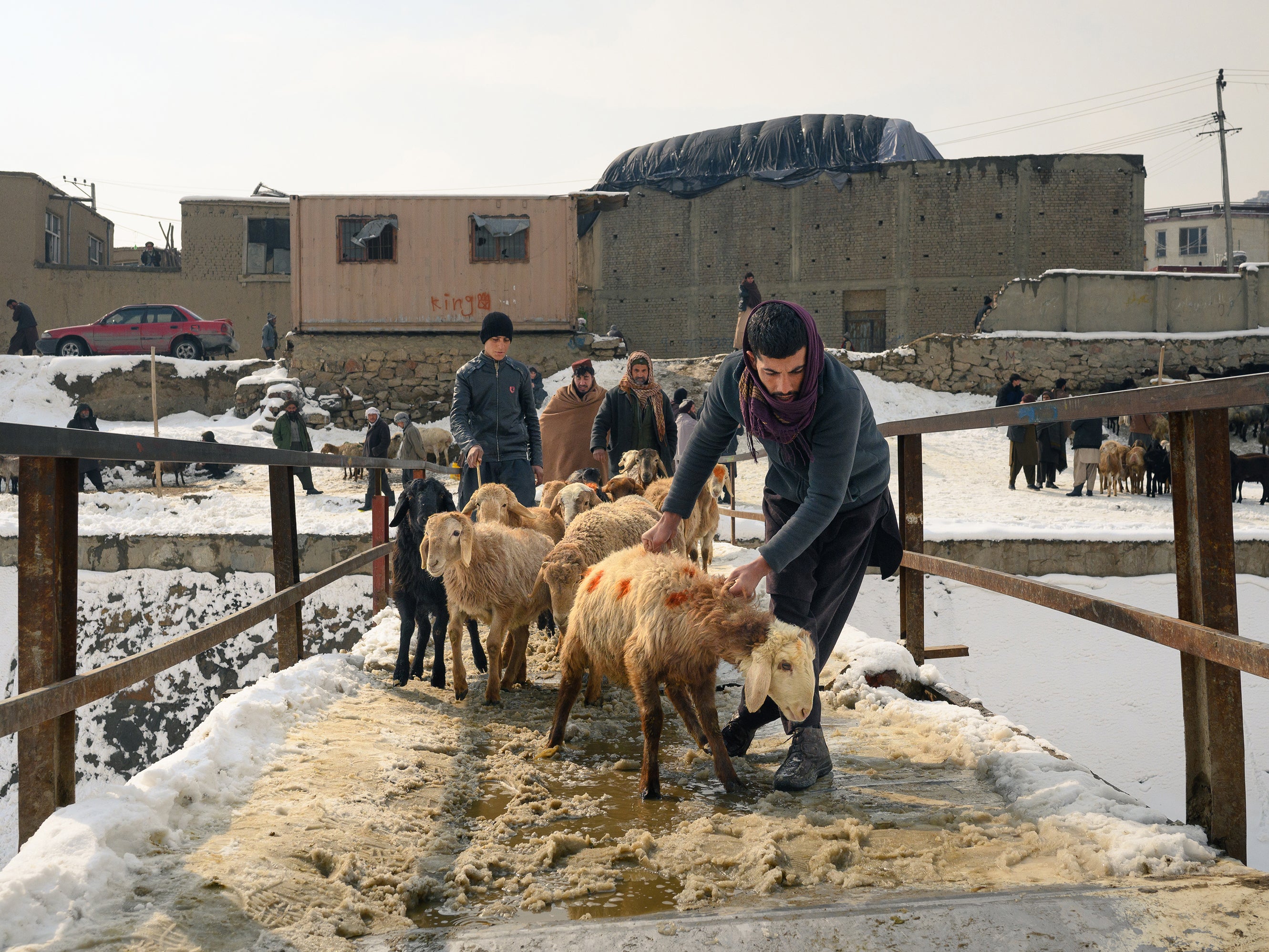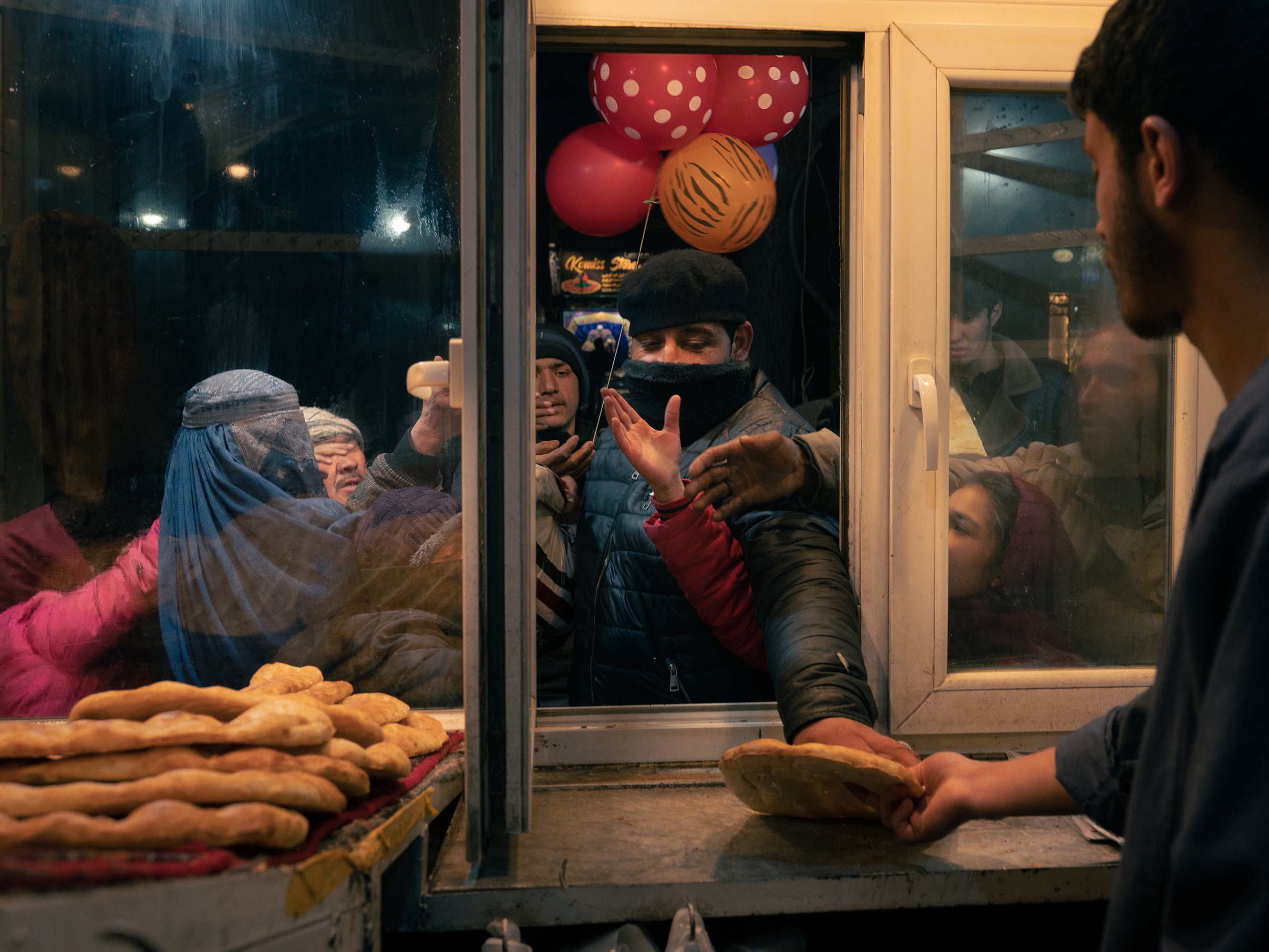The problems Afghans are facing this winter are only getting worse
While officials are better organised than last winter, they say their limited resources – exacerbated by foreign financial sanctions against the Taliban – can reach only a small portion of the needy, writes Pamela Constable

Ankle-deep in mud and slush, a woman named Farzana, 32, squats and scrubs clothes in a bucket. When she stands, her hands are stiff and red. Her daughters are out begging for bread; her sons are collecting rubbish to use as stove tinder. At night, in a mud-walled hut on the outskirts of the Afghan capital, the family of seven huddle together under blankets as the heat slowly dies.
“I never imagined we would be living like this,” she says with a laugh of lingering disbelief. “We had a good house once, but it was destroyed by fighting in the war. My husband had work, but now there is none. As a mother, it pains me to send my children out in this awful cold, but we have no choice.”
As 40 million Afghans struggle through a second winter since the return of Taliban rule, many are facing conditions far worse than during the first. The weather has been exceptionally harsh, with temperatures often near zero at night.
More than 160 people nationwide have died of hypothermia. So have at least 200,000 goats, sheep and other livestock. In isolated northern provinces, many roads are blocked by snow and little emergency aid can be delivered.

According to the World Food Programme, nearly 20 million people face acute food shortages this winter and 6 million face “emergency-level food insecurity”. Many foreign aid projects, which distributed food and supplies across the country last winter, have been cut back or suspended because of an impasse between international donors and Taliban authorities over women’s rights.
Afghan relief officials say they are struggling to fill the gap. At the Ministry of Disaster Management, officials are coordinating with other local agencies to provide emergency aid in vulnerable areas, sometimes using military helicopters to drop firewood, blankets and animal fodder. While officials are better organised than last winter, they say their limited resources – exacerbated by foreign financial sanctions – can reach only a small portion of the needy.

“Ten million Afghans need emergency help this winter but we can barely cover half of that,” says Irfanullah Sharifzoi, spokesperson for the Afghan Red Crescent Society, a private charity that has stored winter supplies in some remote provinces but is now running out. “We can’t receive cash or goods from countries that want to help us, and others are using human lives as a tool to put pressure on our government.”
Foreign aid agencies, however, are outraged by the Taliban’s ban on Afghan women working in their programmes and have demanded that it be rescinded. The order sent hundreds of female workers home just as winter aid efforts were ramping up. Peter Kessler, a spokesperson for the UN Refugee Agency in Kabul, says this could cause a “catastrophic disruption” in delivering help to millions of women and children.
But harsh weather is only one factor in the deepening chill that has settled over Afghan society. People express feelings of accumulated frustration and fatigue, of dwindling options and mounting obstacles, of slipping down yet another rung on the economic ladder. Last winter, many Afghans still had a cushion: a few valuables to sell, a few final pension payments, a forgiving landlord or a generous relative. By now, though, many have exhausted those fallbacks and fallen into debt.
Prices of food and fuel have skyrocketed in recent months, while the foreign-funded distribution programmes that provided millions of Afghans with regular nourishment last winter – rice and flour, sugar and oil – have been sharply cut back. Families that could once afford to buy a month’s worth of coal or wood to heat their homes are now buying only enough to last a few nights.
On a recent day, two women approached an outdoor sale that was stacked with bulging sacks of wood. After poking through the wares and haggling over the price, they eventually left, carrying two small bags of wood chips that cost $2 (£1.70) and would last about five nights. One of them, a mother of six named Malala, says her husband lost his job with a foreign agency when the Taliban took over and has not found work since. When their savings finally ran out some months back, she “had to sell my wedding jewelry. It was hard to give up those memories, but I couldn’t bear my children staring at me because they were hungry.”

Two blocks away, a taxi driver named Hajji Khalil is paying a coal seller for one sack worth about $12. Until this winter, he says, he had bought 18 sacks before cold weather arrived. “I always kept the house warm for my family all winter, but now few people take taxis and I am earning very little,” he says. “We are just eating to survive.”
At traffic circles slick with ice and mud, jobless men peddle trinkets, repair shoes and wave snow shovels at cars. Outside bakeries, women covered in burqas huddle on plastic sacks, beseeching customers to buy them a piece of warm flatbread. An army of men push wheelbarrows along the streets, their empty carts serving as props to keep government beggar patrols at bay and allow them to pretend they are still on the job.
At night under a freezing drizzle, a man named Zarlialai, 40, leans against his rusty barrow. It is time to start walking home but he is holding on to a fading hope that someone might need something carried – and to a sense of pride that he can still feed his wife and four children, even if he has to borrow again to pay the rent.
“I had a shop near here once. I bought and sold used shoes, and business was good,” he says, sighing. “That’s all gone now but people still remember me. Sometimes they give me a little work or money.” Fumbling in his pocket, he counts some tattered bills and smiles. “That’s enough for 11 pieces of bread, so I can go home now,” he says.

The plight of farm animals this winter has also been unprecedented, with record numbers dying from cold and lack of fodder. With the country isolated from the modern world and with foreign investment at a standstill, more Afghans are turning to traditional rural livelihoods, especially raising and selling livestock.
At an open-air market on the city’s edge, hundreds of sheep, goats and cattle huddle on a snow-covered field while buyers and sellers bicker over prices. Some of the animals are coughing and trembling from the cold. Others do not survive the trip to the market at all.
Aman Sharifi, 45, says he brought about 40 animals from Daikundi province last month after he ran out of work and money. He loaded them into open trucks and set out for Kabul but the roads were blocked by snow and the caravan was halted for days.
“It took us almost three weeks to get here, and it was really cold,” Sharifi says. “Six of the sheep died on the road, and I had to throw them out into the snow. Some of the cows got sick, so I had to sell them cheaply before they died, too. It was hard, but we’ve been through worse. Our only choice is to keep going.”
© The Washington Post






Join our commenting forum
Join thought-provoking conversations, follow other Independent readers and see their replies
Comments